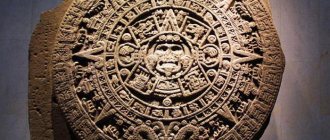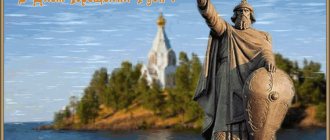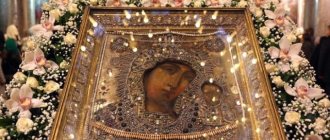Facts you need to know about the Lord's Circumcision.
For the first time, God shed Blood for us on the day of Circumcision. On the eighth day after Christmas.
The kontakion of the current holiday reads: “The Lord endures circumcision of all, and circumcises human sins as if they were good.” We need to remember this and much more today.
The history of the holiday
The Circumcision of the Lord has an ancient history. The festival was first mentioned in the 4th century, when Christian communities began to celebrate Christmas as a separate holiday.
Like all Jewish boys, Jesus of Nazareth underwent the painful rite of circumcision on the 8th day of his birth. Then he received his name, which the Archangel Gabriel indicated to the Virgin Mary when he appeared with the good news.
The Jews adopted the ritual from the Egyptians. It is still practiced in Orthodox Jewish communities; all newborn boys must undergo it as descendants of Abraham, who entered into a covenant with God. The eighth day of a baby’s life was not chosen by chance; the number 8 symbolizes fullness and the achievement of perfection. The blood released from a wound is considered sacred by the Jews.
Postponing the event to a later date was unacceptable and indicated a disdainful and frivolous attitude towards God's laws. Only boys were subjected to the procedure. Among the Jews, husband and wife are one, they must have the same blood and one faith, that is, belong to the same people, therefore, to bless the family, it is enough for the man to be circumcised.
The Feast of the Circumcision of Christ had a significant impact on the direction of the development of Christianity. At the end of the 1st century, Christians split for the first time: a heretical doctrine appeared - docetism, named from the Greek word "dokeo" - "apparent". His followers believed that Jesus did not exist in a human body, but was a disembodied spirit, a supernatural being. However, the Gospel text, which directly describes the circumcision of the infant Christ, became a key argument against the arguments of the heretics. Since the foreskin of Jesus was real, it means that the Savior himself existed, was a mortal man.
During the life of Christ, the procedure for removing the foreskin was replaced by the rite of Baptism. The Apostle Paul called the new sacrament “Spiritual circumcision.”
Both Baptism and Circumcision of the Lord are rites of deliverance of the flesh from sinful beginnings. Saint Theophan the Recluse called the holiday “Circumcision of the Heart,” meaning the cutting off of vices, passions, lustful desires, and destructive habits. A person is freed from everything in which he previously saw pleasure, and begins to live only to serve God and save his own soul.
The decision to abandon the procedure of circumcision was made at the Council of Jerusalem in 49. After this, Christians began to practice only “Circumcision of the Heart,” that is, Baptism.
History of the establishment of circumcision
Circumcision was established almost 4 thousand years ago as a sign of the union of God and Abraham with his offspring. God says this in the Bible: “This is My covenant, which you must keep between Me and you and your descendants after you: that all your males shall be circumcised; circumcise your foreskin: and this will be a sign of the covenant between Me and you.” This was a call to be one people and worship the God of Abraham.
The outward sign of circumcision is a sign of belonging to God. It turns out that a person became part of the chosen people through a bloody operation. Through pain and crying. The sign remained for life. Every man remembered every day to whom he and his family belonged: since ancient times, indestructible alliances have been sealed with blood. Sschmch. Thaddeus (Uspensky) notes: “Circumcision was established by God... It was a sign of entering into a covenant with God, a seal of the promise to be in constant obedience to Him from the days of childhood, to be faithful to Him until the shedding of blood.”
Due to its peculiarity, the rite of circumcision was an indication of carnal passions. Therefore, according to the interpretation of the prophets, the sign of the covenant of circumcision also included internal moral tasks: to circumcise the heart and ears (Lev. 24:41) and not to be “stiff-necked” (Deut. 10:16).
Circumcision was educational in nature and reminded that it was necessary to change the inclinations of the heart. The prophet Jeremiah called the people to this: “Circumcise yourselves to the Lord, and remove the foreskin from your hearts, men of Judah and inhabitants of Jerusalem, lest My anger be revealed like fire and burn unquenchable because of your evil inclinations” (Jeremiah 4). :4).
Veneration of the Feast of the Circumcision of the Lord in Orthodoxy
The circumcision procedure symbolizes cleansing from the Fall. The newborn Jesus was not a bearer of sin, he only incarnated in a human body. However, he was still subjected to the procedure established by Jewish law. Thus, the unity of the Savior with humanity was demonstrated. The Lord set an example in this way: just as he descended to human essence for the sake of a great goal, so people should strive to get closer to God, to spiritual improvement.
The Son of God appeared to people to establish a New Law. But first he had to show respect to the Old Law. Circumcision is the first rite performed after the birth of the Savior. It was a demonstration that the Lord was willing to obey the law of Moses. This indicates his righteousness, bright origin.
An uncircumcised Jew was rejected by society. As Metropolitan Benjamin said, “whoever intends to establish new laws must fulfill the old ones, this will prove that he is not self-willed.”
The only day set for the celebration of the Circumcision of the Lord is January 14th.
The significance of the holiday in Orthodoxy is determined by the confirmation of the Lord’s connection with all people. The festival also acquired the function of a spiritual counterbalance to the Old New Year, which is usually celebrated in a riotous and unbridled manner.
The celebration of the Circumcision of Christ coincides in date with the day of remembrance of Archbishop Basil the Great. Therefore, festive church events on this day are complemented by a liturgy to the saint, which includes the reading of 2 Gospel verses and the singing of magnification. And the evening preceding the holiday, according to folk tradition, is called “Vasiliev”.
The all-night vigil held in honor of the festival includes the following events:
- reading a parable about Abraham’s conversation with God, who ordered the rite of circumcision to be a confirmation of unity with Him;
- reading 2 parables glorifying God the Father and God the Son, who appeared in the human world for the salvation of sinful souls;
- holding the Liturgy of Basil the Great with the reading of the lines of the Apostle;
- a laudatory announcement about the incarnate Savior, a story about his adoption of his real name, about the rite of “Spiritual circumcision”, called Baptism;
- The vigil ends with a New Year's prayer service.
Circumcision of Jesus Christ
The Divine Infant was given the name Jesus at circumcision, which was brought from Heaven by the Archangel Gabriel during the Annunciation. The name Jesus (from the Hebrew “Yehoshua”) consists of two roots: the name of God – Yahweh and the word “salvation”. Therefore, we can understand the name Jesus as God the Savior. The Archangel himself explained this name to Joseph in a dream: “You shall call His name Jesus, for He will save His people from their sins” (Matthew 1:21), because only God can save from sins.
The circumcision was performed by Joseph the Betrothed, guardian of the virginity of the Mother of God. Joseph was not only a spectator of those wonderful days, but also appeared to the uninitiated in the mystery of seedless conception as the father of the Child. Circumcision was performed according to the law by the father of the child, thereby passing on to his son a sign of belonging to the chosen people.
Through circumcision we have clearly seen that Christ is Man. God took on flesh. Our flesh. In ancient times there were heretics, the Docetes, who said that God incarnated ghostly, only creating the appearance of physicality. The fact that Jesus was circumcised refutes this lie. Saint Ephraim the Syrian says: “If Christ was not flesh, then whom did Joseph circumcise? But since He was truly flesh, He was circumcised as a man, and the Child was truly stained with His blood, like the son of man; He was sick and cried in pain, as befits someone with human nature.” The Church points to the reality of the Gospel events and values them. This is the path of our salvation.
David said: “...my mother gave birth to me in sins” (Ps. 50:7). On the eighth day, a sore on the baby’s body indicated guilt in sins. The Lord is sinless, accepts circumcision to show that He becomes the Sacrifice for our sins and accepts our illnesses (Isa. 53). “And for what He was not guilty, for this He suffered as if innocent, as if repeating with David: “What I did not take away, I must give” (Ps. 68:5), i.e. for that sin in which I was not involved “I accept the disease of circumcision,” as St. Demetrius of Rostov writes, “...in circumcision the Master showed us greater humility than in His birth. For at His birth He took upon Himself the form of a man...; in circumcision He took on the form of a sinner, just as a sinner endured the pain due for sin.”
He accepted circumcision to fulfill his covenant with God in a new way. The Lord indicated that the circle of flesh is ending. A new era is beginning, where the words of the prophets will no longer be empty and Christians will circumcise the periphery of their hearts, where all sins are located, and give a pure heart to God. Sschmch. Thaddeus (Uspensky) notes: “It was performed in the image of cutting off the passions of the flesh, cutting off the hardness of the heart itself, which was so disastrous for Israel and so often forced it to retreat from its God. And so our Lord, being sinless, Himself endures circumcision in order to teach to submit to the will of God those who require circumcision of hearts, cleansing from a multitude of sins: “... the Creator of the law fulfills the law,” in order to show by His example how no one can come to God apart from the law of the Lord.” .
Orthodox prayers
The Feast of the Circumcision is lost between the magnificent Christmas and Epiphany festivities, but its significance cannot be diminished. After the nightly pre-holiday vigil, in the morning, believers read holiday prayers, praising the day when Jesus acquired his real name and followed God's law.
Troparion
Voice 1
On the fiery Throne in the Highest, sitting with the Father Without Beginning and Thy Divine Spirit, Thou didst deign to be born on earth from the Unskilled Young Lady, Thy Mother, Jesus, for this reason Thou wast circumcised, as a Man of the day. Glory to Your all-good advice, glory to Your look, glory to Your condescension, O O One Lover of Mankind.
Kontakion
Voice 3
The Lord endures circumcision of all and human sins, because He is Good, He circumcises and gives salvation to the world today. Both the Creator hierarch and the luminous, Divine Hidden of Christ Basil rejoice in the Highest.
Canon
Voice 2nd
Song 1
Irmos: Come, people, let us sing a song to Christ God, who divided the sea and taught the people, even as he learned from the work of Egypt, for he was glorified.
Chorus: Glory to Thee, our God, glory to Thee. The mother of days, bearing the image of the future, is enlightened by Your Christ and sanctified by free poverty; for this reason you were lawfully circumcised in the flesh. (twice)
Glory: Christ accepts circumcision every day at His Nativity, and today He will hide the canopy, shining forth the light of new grace. And now: The same.
Song 3
Irmos: Establish us in You, Lord, by the tree of mortifying sin and planting Your fear in the hearts of us who sing of You. Glory to Thee, our God, glory to Thee. The Word made incarnate, the all-essential, was circumcised at the end of the law; The firstfruits of Divine grace and incorruptible life have been given to us. (twice)
Glory: The fulfiller of the law, not as if he were opposed to God, this Christ became incarnate, and was deemed worthy to be circumcised by His will. And now: The same. Lord have mercy. (three times) Glory, even now.
Sedalen, voice 4th
Like the abyss of love for mankind, you clothed yourself, O Master, in the form of a slave, and you were circumcised in the flesh, bestowing upon all mankind Your great mercy.
Song 4
Irmos: I have heard, O Lord, the hearing of Your gaze, and glorified You, the only One who loves mankind. Glory to Thee, our God, glory to Thee. Circumcision of the Lord, since Christ was circumcised by His will, saving many tongues by grace. (twice)
Glory: Life depicts the future unceasing osmago of the century, in the nude the Lord was circumcised in the flesh. And now: The same.
Song 5
Irmos: Light to the Giver, and Creator of ages, O Lord, instruct us in the light of Your commandments; Don’t we know another God for You? Glory to Thee, our God, glory to Thee. You have passed unspeakably from the Virgin Mother, O Lord, and now you have been vouchsafed to be clothed in human form, like a lawful child, you have fulfilled the law. (twice)
Glory: Be like the night, like the shadow of the law for those who love Israel, who gave birth to Christ appearing from the light of the world that was not covered with light. And now: The same.
Song 6
Irmos: The abyss of many sins surrounds me, and I cry to You, imitate the prophet: raise me from aphids, Lord. Glory to Thee, our God, glory to Thee. The end of the law was accepted, even though Christ was in his infancy, the executor of the law, they accepted circumcision, and resolved the legal oath. (twice)
Glory: Sabbath, the circumcision of the Jewish vacillation, Christ revealed by the wave of the Holy Cross, and the rise of spring grace. And now: The same. Lord have mercy. (three times) Glory, even now.
Kontakion, tone 3
The Lord endures circumcision of all, and human sins, as a blessing, circumcises, and gives salvation to the world today; The Creator hierarch and the luminous Divine secret place of Christ, Basil, rejoices in the highest.
Song 7
Irmos: I serve the golden image in the field of Deira, Thy three fathers, heedless of the godless command, cast into the midst of the fire, watering the waist: blessed art thou, O God of our fathers. Glory to Thee, our God, glory to Thee. Bright and bright is the Nativity of Christ, and the future renewal of the signer of the sacrament today: as the Savior is circumcised by the lawful rite, not as God, but as a man, and the fulfillment of the law. (twice)
Glory: Fulfilling the law, the Creator is circumcised in the flesh today by will, circumcising the sinful winters, and bestowing the call: Blessed art thou, O God of our fathers. And now: The same.
Song 8
Irmos: With the ineffable wisdom of God the Word, who has made up all things, and who has brought from those who are not in existence, bless the works as if they were the Lord, and exalt them unto all ages. Glory to Thee, our God, glory to Thee. On the 8th day the Lord is circumcised like a child; Jesus accepts the name, as the Savior and Lord of the world. (twice)
Glory: For the Nativity of Christ, having woven himself worthily, the all-glorious memory of the saint, who by faith reveres us, sings to the Lord and exalts him to the ages. And now: The same.
Song 9
Irmos: Even before the sun, the lamp of God arose, carnally coming to us from the side of the Maiden, who inexpressibly embodied, blessed, All-pure, We magnify You, the Mother of God. Glory to Thee, our God, glory to Thee. Having transcended the limits of all human nature, Christ is born prenaturally from the Virgin; and as the scripture of the law commands, the flesh is circumcised, and the doer of the law appears. (twice)
Glory: Come, Lords of the glorious naming of Christ in the shrine, we triumph: Jesus has been most gloriously named this day. With simizhe we magnify the memory of the saint. And now: The same.
Greatness
We magnify Thee, Life-Giving Christ, and honor Thy most pure flesh, the lawful circumcision.
History of the celebration
On the territory of Rome, the New Year was traditionally celebrated with colossal intemperance, indulging in pagan tradition. Therefore, the Church set out to establish and consolidate the feast of the Circumcision of the Lord in order to find control for carnal pleasures during this period. The introduction of celebration into the liturgical cycle was a necessary condition for raising moral standards.
The church fathers were perplexed, seeing the unbridled behavior of the people on these holidays, and sought to correct the state of affairs of the Christian faith. This divine holiday became the culmination of Lent, taking place between the Nativity of Christ and His Baptism. To explain the essence of the celebration, the clergy relied on the Jewish tradition, which connected man and the Almighty Lord through this ritual.
About other twelve holidays:
- Nativity
- Presentation of the Blessed Virgin Mary into the Temple
- Ascension of the Lord
When Christianity officially established itself as the state religion on the territory of Rome, liturgical changes could be established not only among the heads of the church, but also through the decisions of the rulers.
This celebration, designed to pacify the carnal misunderstanding of the people, almost completely eradicated the January bacchanalia. The state and the Church were able to suppress unnatural acts and bring forward the moral component.
Interesting! The Christian faith generated enormous influence and spread rapidly throughout the civilized world. The first to truly embrace this religion were the Jewish communities living in the Mediterranean. Soon pagans also began to convert to Christianity. However, some of them were already circumcised in the first days of life, which introduced confusion into the initiation rituals.
Iconography
During celebrations in Orthodoxy, it is customary to place an icon of Archbishop Basil the Great on the lectern in the church. And icons depicting the rite of circumcision of Christ can be found among the paintings inside the walls of temples.
There are few options for writing the icon. Typically the plot involves the following images:
- the action takes place inside the temple premises, the participating characters are on an artificial elevation;
- the characters are clergy, church assistants, the Mother of God, the baby Jesus and the elder Joseph, who was the betrothed (guardian of chastity) of Mary;
- The Savior is held by one of the clergy, Mary and Joseph stand nearby, usually to the left, and near them there is a kneeling servant with a container for ritual sacrifices in his hands;
- the head of the baby Jesus is surrounded by a halo;
- the high priest in ritual vestments, bending over the baby, begins the procedure of removing the foreskin.
Divine service
The circumcision of the Lord is united with the memory of St. Basil the Great.
Christians honor and glorify this great miracle - God’s willingness to humble himself and accept everything prescribed by the Law to man. On this day, a liturgy is served in the church, which includes special chants for the Feast of the Circumcision.
Circumcision of the Lord is a Lord's holiday, connected with the memory of St. Basil the Great, Archbishop of Caesarea in Cappadocia, which is why it is popularly known as St. Basil's Day. When combining these two services, preference is given to the service of St. Basil the Great.
An all-night vigil is celebrated, the polyeleos is sung to the saint, “The Most Honest...” is not sung, but the refrains of the holiday and the saint are sung. There is a special dispensation: “On the eighth day we will be circumcised in the flesh for the sake of salvation...”.
The Liturgy of Basil the Great is celebrated, two Gospel conceptions are read, and the glorification of Basil the Great is sung. The Jesus Prayer is read.
What can and cannot be done at the Circumcision of the Lord
The procedure of circumcision symbolizes the willingness to obey God's law. Consequently, this holiday is a day when one must observe the rules of morality and conscience, remain correct, humble, and respectable. Moreover, this applies to even the smallest actions, for example, you cannot cross the road in the wrong place.
There are also folk signs associated with January 14th. Residents of the territory where sunny weather prevailed on this day will live happily and serenely throughout the year. A clear day promises excellent yields of fruit trees, a windy day promises berries, mushrooms and nuts, and a snowy day promises prosperity and well-being. The frost that falls on the holiday promises a rich harvest of cereal crops, and the ice promises a rich harvest of vegetables.
Troparion, kontakion and canon for the holiday
Troparion, tone 1.
And on the other side of the world, in the 8th sedsi, with the beginningless, and 3 divine thy home. blgov1v was born1tisz flesh, tv7y unskilledz ї©e. today for the sake of њbrёsасz ћko chlkа nfashionable. Glory to your great advice, glory to your goodness, glory to us, even more so, to your extreme descent.
Kontakion, tone 3.
And in all places, cutting is coming. and 3 human sins, which the world consumes, give salvation to me today. pleases the 8 Lords, and 3 the creators of the s™ and 3 the Day, the divine secret of Khrt0v Vasily3.
Library of the Russian Faith Canon of the Circumcision of the Lord →
Read online










